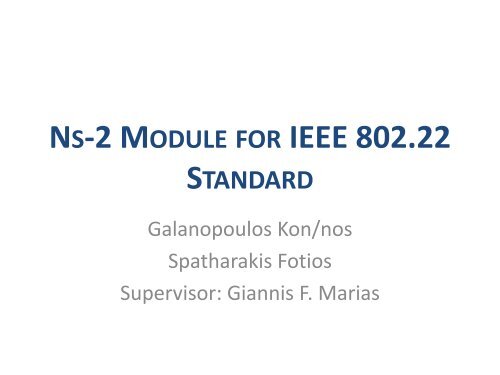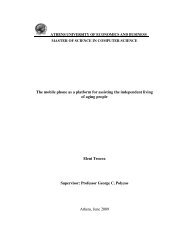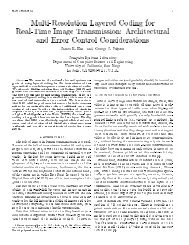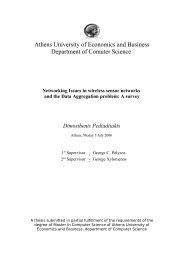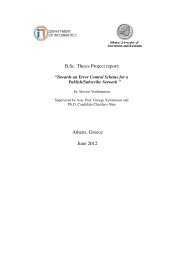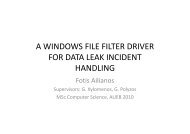ns-2 module for ieee 802.22 standard
ns-2 module for ieee 802.22 standard
ns-2 module for ieee 802.22 standard
Create successful ePaper yourself
Turn your PDF publications into a flip-book with our unique Google optimized e-Paper software.
NS-2 MODULE FOR IEEE <strong>802.22</strong><br />
STANDARD<br />
Galanopoulos Kon/nos<br />
Spatharakis Fotios<br />
Supervisor: Giannis F. Marias
THE IEEE <strong>802.22</strong> STANDARD AND THE MODULE<br />
DEVELOPED FOR NS2. ATTACK SCENARIOS SIMULATED IN<br />
NS2<br />
2/3/2010<br />
Ns-2 Module <strong>for</strong> IEEE <strong>802.22</strong> Standard<br />
2
Presentation Contents<br />
1.About IEEE <strong>802.22</strong><br />
2.Developing the <strong>802.22</strong> <strong>module</strong> <strong>for</strong> NS2<br />
3.Attack scenarios simulation<br />
2/3/2010<br />
Ns-2 Module <strong>for</strong> IEEE <strong>802.22</strong> Standard<br />
3
1.About IEEE <strong>802.22</strong><br />
2.Developing the <strong>802.22</strong> <strong>module</strong> <strong>for</strong> NS2<br />
3.Attack scenarios simulated<br />
ABOUT IEEE <strong>802.22</strong><br />
2/3/2010<br />
Ns-2 Module <strong>for</strong> IEEE <strong>802.22</strong> Standard<br />
4
Why IEEE started developing the<br />
<strong>802.22</strong> Standard(1/2)<br />
• May 2004: According to a Notice of Proposed Rule<br />
Making unlice<strong>ns</strong>ed radios are allowed to operate in TV<br />
bands as long as they don’t interfere with TV services.<br />
• So in November of 2004, a novel wireless air interface<br />
<strong>for</strong> WRAN (Wireless Regional Area Networks) started<br />
being developed using spectrum allocated <strong>for</strong> TV<br />
services.<br />
• Why use TV bands?<br />
– Due to their propagation characteristics<br />
• It is possible to cover exte<strong>ns</strong>ive areas in LOS and NLOS conditio<strong>ns</strong><br />
at lower power levels.<br />
– In suburban and rural areas there is a lot of “whitespace”<br />
in this spectrum<br />
2/3/2010<br />
Ns-2 Module <strong>for</strong> IEEE <strong>802.22</strong> Standard<br />
5
Why IEEE started developing the<br />
<strong>802.22</strong> Standard(2/2)<br />
• By using this protocol, suburban and rural areas can be provided<br />
with broadband/high speed internet access. This can be also used<br />
in developing countries, where these whitespaces are larger.<br />
• Amount of whitespace will be great after the completion of DTV<br />
tra<strong>ns</strong>ition<br />
Source: New America Foundation and Free Press. Measuring the<br />
TV "White Space" Available <strong>for</strong> Unlice<strong>ns</strong>ed Wireless Broadband.<br />
2007<br />
2/3/2010<br />
Ns-2 Module <strong>for</strong> IEEE <strong>802.22</strong> Standard<br />
6
IEEE <strong>802.22</strong> Characteristics<br />
• Service Coverage: 33km– Up to<br />
100km if power is not an issue.<br />
• Use of TV channels of 6-8MHz<br />
bandwidth which provide a data<br />
rate of at least 18Mbps<br />
• Main issue: Lack of interference<br />
with primary users.<br />
– That’s why there are quiet periods,<br />
when se<strong>ns</strong>ing takes place.<br />
• OFDMA modulation with channel<br />
bonding and multiple modulation<br />
schemes according to distance.<br />
• MAC is based on 802.16 MAC<br />
2/3/2010<br />
Ns-2 Module <strong>for</strong> IEEE <strong>802.22</strong> Standard<br />
7
<strong>802.22</strong> Entities<br />
Controls all tra<strong>ns</strong>mit parameters and network characteristics<br />
Per<strong>for</strong>ms se<strong>ns</strong>ing of primary users under BS i<strong>ns</strong>tructio<strong>ns</strong><br />
2/3/2010<br />
Ns-2 Module <strong>for</strong> IEEE <strong>802.22</strong> Standard<br />
8
<strong>802.22</strong> Superframe and frame<br />
structure<br />
Superframe<br />
Frame<br />
2/3/2010<br />
Ns-2 Module <strong>for</strong> IEEE <strong>802.22</strong> Standard<br />
9
Quiet Period Management <strong>for</strong> Se<strong>ns</strong>ing<br />
• Se<strong>ns</strong>ing is a two-stage process<br />
– Stage 1: Fast se<strong>ns</strong>ing (1 ms duration)<br />
– Stage 2: Only if needed, per<strong>for</strong>m fine se<strong>ns</strong>ing (more detailed se<strong>ns</strong>ing – 25 ms<br />
duration)<br />
• Fast se<strong>ns</strong>ing is per<strong>for</strong>med in-band only<br />
• If something is detected during the fast se<strong>ns</strong>ing stage, BS<br />
determines the begin of the fine se<strong>ns</strong>ing stage<br />
• If a particular signature of a tra<strong>ns</strong>mitted signal is detected<br />
during fine se<strong>ns</strong>ing, a BS per<strong>for</strong>ms an out-of-band se<strong>ns</strong>ing<br />
(detects an empty channel to continue tra<strong>ns</strong>mission)<br />
2/3/2010<br />
Ns-2 Module <strong>for</strong> IEEE <strong>802.22</strong> Standard<br />
10
1.About IEEE <strong>802.22</strong><br />
2.Developing the <strong>802.22</strong> <strong>module</strong> <strong>for</strong> NS2<br />
3.Attack scenarios simulation<br />
DEVELOPING THE <strong>802.22</strong> MODULE<br />
FOR NS2<br />
2/3/2010<br />
Ns-2 Module <strong>for</strong> IEEE <strong>802.22</strong> Standard<br />
11
Development process <strong>for</strong> <strong>802.22</strong><br />
<strong>module</strong> <strong>for</strong> <strong>ns</strong>-2<br />
• There is no <strong>module</strong> published/known <strong>for</strong> <strong>ns</strong>-2<br />
<strong>for</strong> <strong>802.22</strong><br />
• There are a lot of similarities between 802.16 and<br />
<strong>802.22</strong><br />
– Develop the <strong>802.22</strong> <strong>module</strong> by extending an existing<br />
and simplified 802.16 <strong>module</strong>.<br />
• We also studied two more 802.11 <strong>module</strong>s:<br />
– The one enhanced in <strong>ns</strong>2-34 in order to understand<br />
the development process and one developed by NIST.<br />
2/3/2010<br />
Ns-2 Module <strong>for</strong> IEEE <strong>802.22</strong> Standard<br />
12
Module functionality<br />
• OFDMA parameters according to <strong>802.22</strong><br />
• MAC level of <strong>802.22</strong><br />
• Three types of se<strong>ns</strong>ing:<br />
– Simple se<strong>ns</strong>ing (Algorithm A)<br />
– In-frame se<strong>ns</strong>ing (Algorithm B)<br />
– Adaptive se<strong>ns</strong>ing (Algorithm C)<br />
• Inter-cell channel sharing<br />
• Synchronization<br />
2/3/2010<br />
Ns-2 Module <strong>for</strong> IEEE <strong>802.22</strong> Standard<br />
13
Interference avoidance<br />
• Cell initiates channel<br />
scanning process in<br />
order to switch to a<br />
vacant channel<br />
– BS send SCANREQ<br />
message to a CPE which<br />
will search the spectrum<br />
serially.<br />
– CPE in<strong>for</strong>ms the cell<br />
about the presence of an<br />
unused channel to<br />
switch to.<br />
Time needed <strong>for</strong> channel change<br />
2/3/2010<br />
Ns-2 Module <strong>for</strong> IEEE <strong>802.22</strong> Standard<br />
14
Interference avoidance among<br />
multiple cells<br />
• Providing that:<br />
– There are enough unused channels<br />
– There are multiple cells using the same channel in a specific area<br />
each cell switches to an unused channel.<br />
• Cells must be coordinated about the channel change process.<br />
Resolution time ≈ 0.3s<br />
2/3/2010<br />
Ns-2 Module <strong>for</strong> IEEE <strong>802.22</strong> Standard<br />
15
Overhead of fast se<strong>ns</strong>ing in network’s<br />
tra<strong>ns</strong>mission data rate (1/3)<br />
• Co<strong>ns</strong>idering:<br />
– T se<strong>ns</strong>e : duration of fast se<strong>ns</strong>ing<br />
– T frame : duration of frame<br />
Then tra<strong>ns</strong>mission efficiency can be computed as:<br />
2/3/2010<br />
Ns-2 Module <strong>for</strong> IEEE <strong>802.22</strong> Standard<br />
16
Overhead of fast se<strong>ns</strong>ing in network’s<br />
tra<strong>ns</strong>mission data rate (2/3)<br />
• However multiple fast se<strong>ns</strong>es can also be<br />
per<strong>for</strong>med in each frame<br />
• Frame is split to multiple parts<br />
• Tra<strong>ns</strong>mission efficiency (co<strong>ns</strong>idering k<br />
se<strong>ns</strong>es/frame)<br />
2/3/2010<br />
Ns-2 Module <strong>for</strong> IEEE <strong>802.22</strong> Standard<br />
17
Overhead of fast se<strong>ns</strong>ing in network’s<br />
tra<strong>ns</strong>mission data rate (3/3)<br />
2/3/2010<br />
Ns-2 Module <strong>for</strong> IEEE <strong>802.22</strong> Standard<br />
18
<strong>802.22</strong> Inter-Cell Synchronization<br />
• Synchronization of QPs <strong>for</strong> better<br />
detection of primary users with<br />
inter-cell beaco<strong>ns</strong><br />
– E.g. two overlapping BSs, BS 1 and<br />
BS 2 . BS 1 sends an inter-cell<br />
beacon to BS 2 . BS 2 tries to slides<br />
frames with the following rule:<br />
• If (FDC – O + O T ≤ ceil (FDC/2)<br />
x Rv<br />
), slide frames right by FDC – O T x<br />
+ O R v<br />
• Else slide frames left by (O T x -<br />
O R v ).<br />
• FDC: Frame Duration Code (time<br />
duration)<br />
Source: Bian, K. and Park, J. 2008. Security<br />
vulnerabilities in IEEE <strong>802.22</strong>.<br />
2/3/2010<br />
Ns-2 Module <strong>for</strong> IEEE <strong>802.22</strong> Standard<br />
19
Importance of self-coexistence<br />
2/3/2010<br />
Ns-2 Module <strong>for</strong> IEEE <strong>802.22</strong> Standard<br />
20
Channel sharing simulation (1/2)<br />
• If all available channels are used and overlapping cells cause low SIR to<br />
each other.<br />
• In this case, synchronized cells can decide to share the same channel.<br />
• Simulation scenario: Three cells in the same channel<br />
2/3/2010<br />
Ns-2 Module <strong>for</strong> IEEE <strong>802.22</strong> Standard<br />
21
Channel sharing simulation (2/2)<br />
If CPE finds out that there are no channels available, it changes back to original<br />
one and triggers the channel sharing process<br />
Channel 1: 2 cells (channel sharing)<br />
Channel 2: 1 cell (exclusive use)<br />
cell 3<br />
cell 2<br />
cell 1<br />
Channel 2<br />
Channel 1<br />
2/3/2010<br />
Ns-2 Module <strong>for</strong> IEEE <strong>802.22</strong> Standard<br />
22
1.About IEEE <strong>802.22</strong><br />
2.Developing the <strong>802.22</strong> <strong>module</strong> <strong>for</strong> NS2<br />
3.Attack scenarios simulation<br />
ATTACK SCENARIOS SIMULATION<br />
2/3/2010 Ns-2 Module <strong>for</strong> IEEE <strong>802.22</strong> Standard 23
Se<strong>ns</strong>ing vulnerabilities<br />
• <strong>802.22</strong> is not immune to attacks<br />
• An attacker is possible to predict quiet periods<br />
and avoid sending spurious packets<br />
• Cell loses data in co<strong>ns</strong>tant rate without<br />
detecting the attack<br />
• Two countermeasures are proposed<br />
– In-frame se<strong>ns</strong>ing<br />
– Adaptive se<strong>ns</strong>ing<br />
2/3/2010<br />
Ns-2 Module <strong>for</strong> IEEE <strong>802.22</strong> Standard<br />
24
In-frame se<strong>ns</strong>ing (Algorithm B)<br />
• In case of a collision:<br />
– Cell stops tra<strong>ns</strong>missio<strong>ns</strong> <strong>for</strong> a number of slots without changing<br />
the frame length.<br />
– At these slots all CPEs per<strong>for</strong>m fast se<strong>ns</strong>ing<br />
– If a CPE detects energy then fine se<strong>ns</strong>ing is per<strong>for</strong>med.<br />
– Se<strong>ns</strong>ing slots vary in time<br />
2/3/2010<br />
Ns-2 Module <strong>for</strong> IEEE <strong>802.22</strong> Standard<br />
25
Adaptive se<strong>ns</strong>ing (Algorithm C)<br />
• In case of a collision:<br />
– All idle CPEs per<strong>for</strong>m fine se<strong>ns</strong>ing at the slots collision<br />
occurred<br />
– Attacker must be detected from all CPEs per<strong>for</strong>ming<br />
the se<strong>ns</strong>ing.<br />
– After detection cell begi<strong>ns</strong> the channel change<br />
process.<br />
• Energy co<strong>ns</strong>umption is an important factor.<br />
– Se<strong>ns</strong>ing cannot be per<strong>for</strong>med in infinite time<br />
– Energy loss due to se<strong>ns</strong>ing shouldn’t override energy<br />
loss caused by interference.<br />
2/3/2010<br />
Ns-2 Module <strong>for</strong> IEEE <strong>802.22</strong> Standard<br />
26
Se<strong>ns</strong>ing energy cost (1/2)<br />
• Energy loss caused by interference:<br />
– k: interference duration in frames<br />
– P RC : Reception energy/slot<br />
– a: # of slots collided<br />
• Energy loss caused by se<strong>ns</strong>ing<br />
– λ: frames where se<strong>ns</strong>ing takes place<br />
– P RT : Reporting energy/frame<br />
2/3/2010<br />
Ns-2 Module <strong>for</strong> IEEE <strong>802.22</strong> Standard<br />
27
Se<strong>ns</strong>ing energy cost (2/2)<br />
• Se<strong>ns</strong>ing should take place<br />
up to a level of λ frames:<br />
– n: # of CPEs which per<strong>for</strong>m<br />
se<strong>ns</strong>ing<br />
• For the graph at the right<br />
assume:<br />
– n = 3 CPEs<br />
– a = 1 slot/frame<br />
– i = 2 (P RT = 2P RC )<br />
2/3/2010<br />
Ns-2 Module <strong>for</strong> IEEE <strong>802.22</strong> Standard<br />
28
Simulation<br />
scenarios (1/2)<br />
•Cell with one BS and 3<br />
CPEs<br />
•Attacker causes<br />
interference to the cell<br />
by sending packets in 3<br />
contiguous slots<br />
•Attacker avoids sending<br />
packets during fast<br />
se<strong>ns</strong>ing<br />
•Victim: 1 CPE.<br />
cell switches to a new channel<br />
2/3/2010<br />
Ns-2 Module <strong>for</strong> IEEE <strong>802.22</strong> Standard<br />
29
Simulation<br />
scenarios (2/2)<br />
•Same concept as<br />
be<strong>for</strong>e<br />
•Cell with one BS and<br />
3 CPEs<br />
•Attacker causes<br />
interference to the cell<br />
by sending packets in<br />
5 random slots<br />
•Victim: 2 CPEs.<br />
cell switches to a new channel<br />
2/3/2010<br />
Ns-2 Module <strong>for</strong> IEEE <strong>802.22</strong> Standard<br />
30
Future Work<br />
• Enhancements after <strong>standard</strong>ization<br />
• More types of se<strong>ns</strong>ing, including trust models<br />
• Improve scheduling mechanisms in order to<br />
reward CPEs that per<strong>for</strong>m se<strong>ns</strong>ing<br />
• Improve channel sharing scheduling<br />
2/3/2010 Ns-2 Module <strong>for</strong> IEEE <strong>802.22</strong> Standard 31


